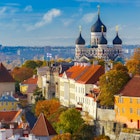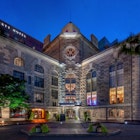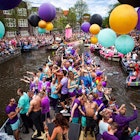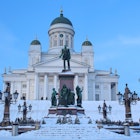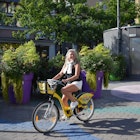The prettiest city in Europe, top spot for a stag do, or the shady home of Cold War espionage? Tallinn has many faces, but it does not feel like a place gripped by subterfuge. The Old Town is so cute that it borders on saccharine. The streets are frozen in white, the iron lamplights jet black against the stonework. It is indisputably lovely. But Tallinn’s beautiful Old Town hides a history rich in betrayal.
Tallinn’s crucial strategic position between Russia and the West meant that as the Cold War developed, her pretty streets were seething with spies and double agents from all sides, waiting to be sent either east or west. In this extract from a longer piece in Lonely Planet Magazine, we take a tour of Tallinn’s most secretive sights.
Hotel Viru
There is no 23rd floor button in the elevator of the grand Hotel Viru, but a short flight of stairs leads up to the floor that isn’t there. This January, Peep Ehasalu, the jovial manager of the Hotel Viru, finally succeeded in his aim to have this secret floor converted into a museum.
The first room, formerly a broom cupboard, has been converted to a Soviet-style manager’s office, complete with telephones and a TV from the era, as well as what Peep describes as a musty ‘Soviet smell’. It comes from the original, and now rather yellowed, lino flooring.
The second room has the blinds drawn tight. The walls are lined with bulky green and silver machinery, an array of knobs with buttons and switches covering every metallic surface. This is where four KGB officers would sit each day, intercepting radio waves from Helsinki and sending cables to Moscow. It was also where information from the 60 or so hotel rooms that were routinely bugged would be processed. ‘It was quite normal,’ says Peep. ‘Surveillance was a way of life in this city.’
St Olaf’s Church
When St Olaf’s Church was built in the 12th century, it was the tallest building in the world. An informal pact by developers has ensured it is still the highest point in Tallinn, and the viewing platform, at the foot of its austere black spire, is proudly recommended by Estonians as the best vantage point in the city. The Soviets, with no time for such sentimental nonsense as civic pride, promptly took over the church and used its spire as their main radio and TV-jamming station.
When the authorities turned the St Olaf’s jamming station on, sending out waves of fuzz on the same frequencies as the Finnish broadcasts, it was so powerful that it briefly blocked the reception in Helsinki itself.
Museum of Occupations
The Museum of Occupations lays out in exhaustive detail the extent to which everyday life in Tallinn was monitored by the Soviets. Curator Heiki Ahonen shows us the newest arrivals. An innocent-looking metal box folds out into a document photocopier. A pinprick in a false wall has a fish-eye lens on the reverse side, offering a remarkably wide angle view into a neighbouring room. A briefcase, used to carry secret documents, opens up to reveal cardboard compartments, each of which will explosively self-destruct with the turn of a key.
It is the stuff of schoolboy imaginations, but the real-life consequences of such fantastical contraptions are made clear by the wooden suitcases on the museum floor. ‘Many families in Tallinn will have one of these suitcases,’ says Heiki. ‘Before prisoners were released from labour camps, they had to make a suitcase to take back any possessions they had left. Everyone knew what a suitcase like this represented.’
Toompea Castle
Today, Toompea is home to the Estonian Parliament. Yet back in 1991, the castle acted much as it did when it was first built in the 13th century - as Tallinn’s last line of defence.
Like thousands of other ordinary Tallinn residents desperate to protect their country from Soviet attempts to retake control, Aadu Jögiaas volunteered for the newly formed Estonian Defence League. His radio experience saw him appointed head of national communications. The Russians again invaded Estonia on 20 August 1991, and by the time they reached the outskirts of Tallinn, Aadu and his team, holed up in Toompea Castle, had picked up their military radio communications.
On 21 August at 4.30am, Aadu heard the Soviet army announce that they had forcibly entered Tallinn’s TV tower, and were awaiting instructions - presumably to take over all of the strategically important buildings in the city. This was the moment that Aadu and his team had been waiting for. As the military commander started to issue his orders, the radio amateurs, barricaded in Toompea, jammed the frequency - just as the Soviet jammers had blocked Finnish TV signals from St Olaf’s spire for years.
‘We jammed them for three hours, so successfully that they could not receive any reports,’ says Aadu. ‘Eventually they gave up.’ By now, there were news reports that a conjoining coup in Moscow itself had failed. A short while later, the army withdrew from Tallinn’s TV tower, and Estonian independence was secured - without a single death.
This article is an excerpt from a longer piece by Matt Bolton in Lonely Planet Magazine.
Lonely Planet Magazine has a host of travel tips and adventure inspiration for £3.70.




